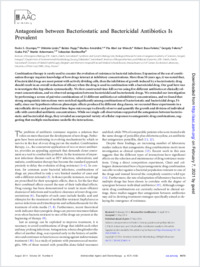Antagonism between bacteriostatic and bactericidal antibiotics is prevalent.
- Ocampo PS Institute of Integrative Biology, ETH Zürich, Zürich, Switzerland Department of Environmental Microbiology, Eawag, Dübendorf, Switzerland paolosocampo@gmail.com.
- Lázár V Synthetic and Systems Biology Unit, Biological Research Centre, Hungarian Academy of Sciences, Szeged, Hungary.
- Papp B Synthetic and Systems Biology Unit, Biological Research Centre, Hungarian Academy of Sciences, Szeged, Hungary.
- Arnoldini M Department of Environmental Microbiology, Eawag, Dübendorf, Switzerland Institute of Biogeochemistry and Pollutant Dynamics, ETH Zürich, Zürich, Switzerland.
- Abel zur Wiesch P Division of Global Health Equity, Brigham and Women's Hospital/Harvard Medical School, Boston, Massachusetts, USA.
- Busa-Fekete R Linear Accelerator Laboratory, University of Paris-Sud, CNRS, Orsay, France.
- Fekete G Synthetic and Systems Biology Unit, Biological Research Centre, Hungarian Academy of Sciences, Szeged, Hungary.
- Pál C Synthetic and Systems Biology Unit, Biological Research Centre, Hungarian Academy of Sciences, Szeged, Hungary.
- Ackermann M Department of Environmental Microbiology, Eawag, Dübendorf, Switzerland Institute of Biogeochemistry and Pollutant Dynamics, ETH Zürich, Zürich, Switzerland.
- Bonhoeffer S Institute of Integrative Biology, ETH Zürich, Zürich, Switzerland.
- 2014-05-29
Published in:
- Antimicrobial agents and chemotherapy. - 2014
Anti-Bacterial Agents
Antibiotics, Antineoplastic
Cytostatic Agents
Drug Antagonism
Escherichia coli
High-Throughput Screening Assays
Microbial Sensitivity Tests
Microfluidic Analytical Techniques
Single-Cell Analysis
Time-Lapse Imaging
English
Combination therapy is rarely used to counter the evolution of resistance in bacterial infections. Expansion of the use of combination therapy requires knowledge of how drugs interact at inhibitory concentrations. More than 50 years ago, it was noted that, if bactericidal drugs are most potent with actively dividing cells, then the inhibition of growth induced by a bacteriostatic drug should result in an overall reduction of efficacy when the drug is used in combination with a bactericidal drug. Our goal here was to investigate this hypothesis systematically. We first constructed time-kill curves using five different antibiotics at clinically relevant concentrations, and we observed antagonism between bactericidal and bacteriostatic drugs. We extended our investigation by performing a screen of pairwise combinations of 21 different antibiotics at subinhibitory concentrations, and we found that strong antagonistic interactions were enriched significantly among combinations of bacteriostatic and bactericidal drugs. Finally, since our hypothesis relies on phenotypic effects produced by different drug classes, we recreated these experiments in a microfluidic device and performed time-lapse microscopy to directly observe and quantify the growth and division of individual cells with controlled antibiotic concentrations. While our single-cell observations supported the antagonism between bacteriostatic and bactericidal drugs, they revealed an unexpected variety of cellular responses to antagonistic drug combinations, suggesting that multiple mechanisms underlie the interactions.
- Language
-
- English
- Open access status
- bronze
- Identifiers
-
- DOI 10.1128/AAC.02463-14
- PMID 24867991
- Persistent URL
- https://folia.unifr.ch/global/documents/265575
Statistics
Document views: 55
File downloads:
- fulltext.pdf: 0
